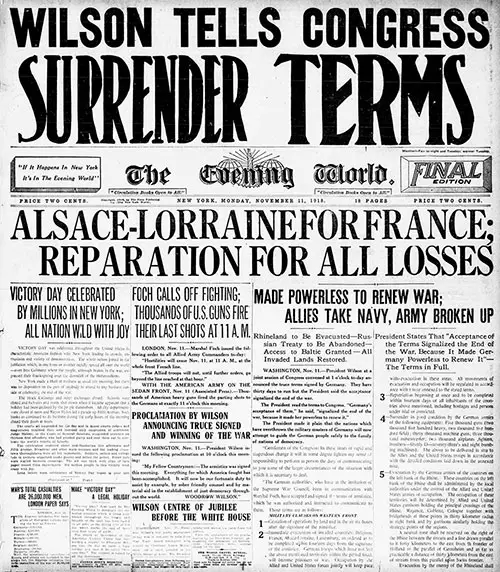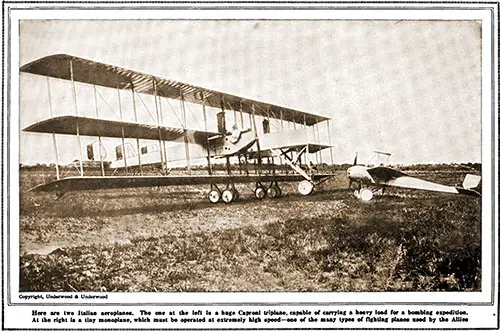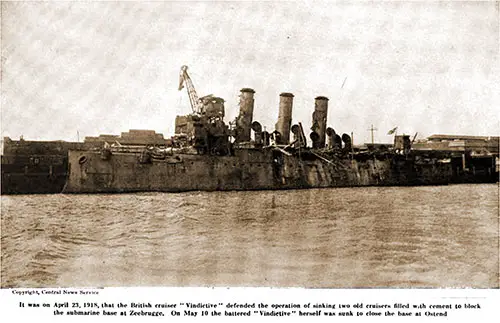The Armistice, November 11, 1918

Front Page, The Evening World Newspaper, Final Edition, New York, Monday, 11 November 1918. "Alsace-Lorraine for France, Reparation for All Loses, [Germany] Made Powerless to Renew War; Allies Take Navy, Army Brokien Up, Foch Calls of Fighting; Thousand of US Guns Fire Their Last Shots at 11 am. Proclamation by Wilson Announcing Truce Signed and Winning of the War. Victory Day Celebrated by Millions in New York; All Nation WIld with Joy." Library of Congress. GGA Image ID # 1929736fe9
So long as the Germans continued to resist stubbornly, there was little progress in the negotiations. But the collapse of Austria forced the Germans to see that further resistance was useless so that the strenuous efforts of the military class to rally the nation to defend its threatened frontiers fell flat.
On November 9, German envoys appeared at Foch's headquarters and transmitted home the conditions on which he would grant an armistice. A revolt of the fleet now hastened the German surrender, rising's in the large towns and William II's flight to Holland.
On November 11, Germany accepted the armistice. On the last morning of hostilities, the British entered Mons, where more than four years earlier they had fired their first shots. The French and Americans advanced to Sedan.
By the terms imposed by Foch, the allies were to hold the line of the Rhine, and Germany was to surrender most of its military stores and fleet. There may still be a delay before a formal treaty can be settled, but the armistice shows the certainty of an honorable peace upon terms that will remove from the world the perils of German domination.

Here Are Two Italians Aero Planes. The One on the Left Is a Huge Caproni Triplane, Capable of Carrying a Heavy Load for a Bombing Expedition. At the Right Is a Tiny Monoplane Which Must Be Operated at Extremely High Speed – One of the Many Types of Fighting Planes Used by the Allies. Photograph © Underwood & Underwood. The Story of the Great War, Volume XIV, 1919. GGA Image ID # 1809b93f03
Home Problems 1916-1918
Britain's strenuous military effort was the more wonderful since many home problems seemed so pressing that the Lloyd George government felt compelled to deal with them, even at the risk of diverting attention from getting on with the war.
These were Ireland's condition, the reform of Parliament, and the establishment on broader lines of a national system of education.
In Ireland, the military government, set up after the Dublin rebellion, maintained order but increased discontent. Bye elections showed that the Nationalist voters were abandoning Ireland and their old leaders in favor of Sinn Fein, and it was Sinn Fein, to little purpose that the "parliamentary party" vied with the Sinn Feiners in their denunciations of the government.
This was especially the case when, after the death of John Redmond, who had supported the war, his place as Nationalist leader went to John Dillon, who refused to help to recruit and strongly opposed a tardy proposal of the government to extend compulsory service to Ireland.
Under such conditions, attempts at conciliation necessarily broke down. An Irish Convention, in which Unionists and Nationalists discussed the possibility of a common Irish reform policy, produced no result. Meanwhile, though clamoring for the execution of the Home Rule Act, the party of Dillon declared that no conscription was acceptable unless imposed by an Irish Parliament.
This demand involved the repudiation of the Act of 1914, which had reserved national defense to the Westminster parliament. The government's vacillations, which first proposed and then postponed indefinitely a plan for Irish conscription, only made matters worse. It became clear that the Irish question could only be settled after the peace.
Meanwhile, the centralization of all administration in London as a result of war conditions was creating a reaction in favor of some federal scheme for all parts of the United Kingdom, as a result of which some of the more obvious Irish complaints might be remedied.
Beyond that, the magnificent part played by the Dominions beyond the seas in the great war brought to thoughtful minds a more distinct vision of some Imperial federation by which the various units of the Empire, while each living in perfect freedom, could be brought together by common machinery to formulate imperial policy and defense.
The Parliamentary Reform Act of 1918
A general agreement made easy the passage of a new Reform Act in 1917. By it, a further approach was made towards universal suffrage in three chief directions.
The number of voters was increased, notably by the simplification of registration, the shortening of the qualifying term of residence, by giving votes to all sailors and soldiers, even when on service abroad, and by extending the franchise to all women over thirty years of age, who had the qualifications of male voters or were the wives of voters.
This latter change was yielded by general consent as a recognition of the work done by women for the national defense, though the fear of the women outvoting the men led in their case to an illogical postponement of the voting age.
A further approach towards equality of representation was made by depriving towns of under fifty thousand ^habitants of their members, by redistributing the constituencies according to population, a process which largely increased the number of representatives of the great towns and industrial districts.
No voter was allowed to vote for more than two constituencies, and the freehold franchise for counties was abolished. The Irish members were kept at their old number so that Ireland became more over-represented than ever. Henceforth, all elections were to be held on the same day, and the first general election under the franchise was subsequently fixed for December 14, 1918.

It Was on April 23, 1918, That the British Cruiser “vindictive” Defended the Operation of Sinking Two Old Cruisers Filled with Cement to Block the Submarine Base at Zeebrugge. On May 10, the Battered “Vindictive” Herself Was Sunk to Close the Base at Ostend. Photograph © Central News Service. The Story of the Great War, Volume XIV, 1919. GGA Image ID # 180a404b15
Education and National Reconstruction 1916-1918
Among the new men brought into politics in 1916 was Herbert Fisher, a University teacher, who was made Minister of Education on the novel ground of his acquaintance with the subject.
The Education Act of 1918, and the administrative reforms attending it, extended the principle of the Act of 1902 by which the counties and county boroughs were made responsible for education within their areas. The full results of the new policy can only be seen after the war.
But an immediately beneficial result followed from the increased sums devoted by the State to education by which teachers' salaries were improved, staffs were strengthened, and schools opened, extended, and better coordinated.
Such measures are but one aspect of the general problem of reconstruction after the war, on the right solution of which will depend not only on the future of our education, but the necessary social and economic changes which are needed to improve the relations of capital and labor, the housing of the people, and the material and moral well-being of the whole of the Empire.
It is only by a vigorous policy of reconstruction that the means can be found to enable the British Empire to face a future that should make the democracy united, happy, prosperous, serious, and free.
Tout, Thomas F. M.A., F.B.A. "Chapter II: George V. and the Great War (1910-1918)" in An Advanced History of Great Britain From the Earliest Times to 1918, Longmans, Green, and Co., New York, 1920, Pages 740-765.
